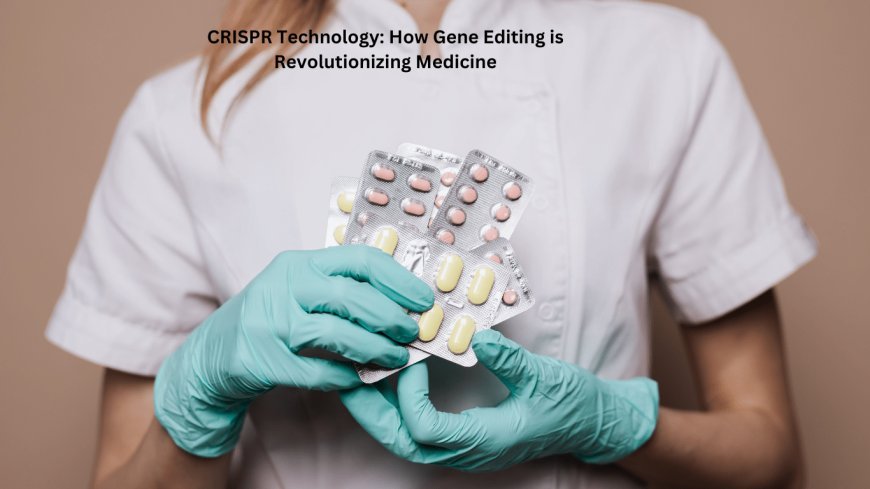CRISPR Technology: How Gene Editing is Revolutionizing Medicine
Discover how CRISPR technology is transforming modern medicine, from curing genetic disorders to personalized treatments. Explore the future of gene editing today.

Introduction
New medical advancements have changed medicine, but CRISPR gene editing may be the most significant. Imagine a tool that could cut and edit individual genes in a live creature, curing genetic disorders, personalizing therapies, and even eliminating certain situations. This is the promise of CRISPR technology, which has revolutionized healthcare.
In this blog, we'll explore CRISPR's science, how it's revolutionizing medical care, and its future. Keep reading to learn how gene editing works and why it's so popular in medicine. Keep up with one of medicine's most intriguing developments.
What is CRISPR Technology?
CRISPR—Clustered Regularly Interspaced Short Palindromic Repeats—sounds long. Essentially "editing" the genetic code, it's a new method that lets scientists change DNA at specific spots. Think of it as a molecular scissors that cuts, adds, or changes cell DNA.
Originally discovered in bacteria, CRISPR protected them against viruses. Scientists refined this technology to modify genes in humans and other species. CRISPR allows scientists to target genes and make alterations that fix genetic mistakes or improve disease resistance.
How CRISPR is Revolutionizing Medicine
-
Curing Genetic Disorders
Perhaps CRISPR's most enticing prospect is curing hereditary diseases. Sickle cell anemia, cystic fibrosis, and muscular dystrophy, which have tormented millions for decades, might be treated by directly modifying their DNA. By altering stem cells' DNA and returning them to form healthy red blood cells, sickle cell anemia researchers have achieved progress. This method has worked in clinical studies and may cure additional hereditary problems. -
Cancer Treatment: Targeting the Root Cause
CRISPR is also revolutionizing cancer therapy. Gene editing may target malignant cells without hurting healthy ones, unlike chemotherapy or radiation, which target all fast dividing cells. Researchers are using CRISPR to change immune cells like T-cells to better detect and fight cancer. This method may treat blood malignancies including leukemia, according to pioneering study. -
Personalized Medicine
One of the most fascinating uses of CRISPR is customized medicine. Personalized medicine tailors therapies to a patient's genetics, enhancing success. By utilizing CRISPR to detect disease-causing genetic abnormalities, scientists may create targeted treatments. This makes treatments more accurate, effective, and safe than traditional ones. -
Gene Therapy for Infectious Diseases
CRISPR has being studied for genetic abnormalities, but it may potentially fight infectious infections. CRISPR might cure HIV, malaria, and the flu by altering pathogen genes or boosting the immune system's response to infections. Early trials have indicated that CRISPR may deactivate the HIV virus in human cells, which might lead to new therapies or a cure. -
Regenerative Medicine
CRISPR has huge regenerative medicine potential. Researchers are studying CRISPR to repair and regenerate tissues and organs. CRISPR's regenerative medicine applications are practically unlimited, from producing new cells to replace cardiac tissue after a heart attack to promoting nerve cell development for spinal cord injury.
Ethical Concerns and Challenges
CRISPR raises ethical issues like any new technology. Key considerations include:
The ability of CRISPR to change the human germline, which might affect future generations, remains contentious. "Designer babies." concern about unexpected results.
CRISPR may change DNA off-target despite its precision. Researchers prioritize gene editing accuracy to avoid harmful mutations.
Equity and Access: Gene editing may be restricted to wealthy societies, causing health inequities.
The Future of CRISPR in Medicine
The future of CRISPR is intriguing yet challenging. As technology advances, applications may get more complicated and imaginative. Scientists improve CRISPR accuracy and efficiency. New CRISPR-Cas9 alternatives like CRISPR-Cas12 and CRISPR-Cas13 are being developed to increase gene-editing accuracy and prevent mutations.
Another exciting finding is gene drives, which may transmit malaria-resistant mosquito genetics. It may treat centuries-old ailments.
Conclusion: CRISPR's Promise for the Future of Medicine
CRISPR transforms medicine. Numerous methods may treat genetic defects, alter cancer treatment, and tailor care. CRISPR might transform disease treatment and prevention despite ethical and technical hurdles.
Researchers may eliminate hereditary disorders and improve focused therapy. Healthcare's future depends on CRISPR technology, and we're just starting.
FAQs:
1. What disorders may CRISPR treat? The CRISPR cure for sickle cell anemia, cystic fibrosis, muscular dystrophy, and cancer. HIV treatment and prevention are possible.
2. Safe CRISPR use? CRISPR is promising in clinical trials but developing. Scientists are eliminating off-target mutations and assuring drug safety before usage.
3. What distinguishes CRISPR from gene therapy? Traditional gene therapy inserts or replaces DNA. CRISPR lets scientists directly tweak DNA for more precise and concentrated changes.
4. Can CRISPR create "designer babies"? CRISPR germline editing raises the ethical issue of genetic change. CRISPR research now treats illness, not improves.
5. Does CRISPR have ethical issues? Unexpected mutations, germline editing, and healthcare inequalities are ethical issues. Debate and regulation continue on these issues.

 Najmul Hasan
Najmul Hasan 





